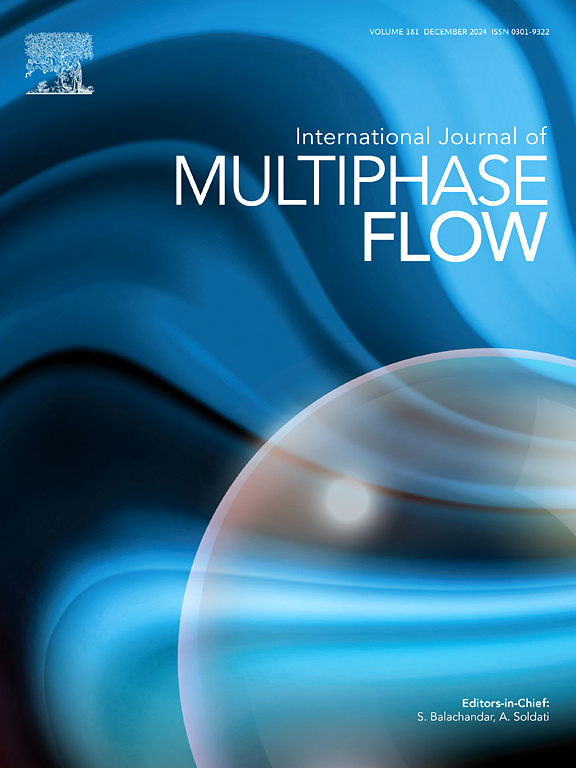Hollow droplet impact on a micro-trench hydrophilic surface
IF 3.6
2区 工程技术
Q1 MECHANICS
International Journal of Multiphase Flow
Pub Date : 2025-03-08
DOI:10.1016/j.ijmultiphaseflow.2025.105198
引用次数: 0
Abstract
Hollow droplet impact on a solid surface occurs in applications ranging from controllable bio-medicine, thermal spray coating and additive manufacturing. In this work, we experimentally study the impact dynamics of silicone oil hollow droplets on a hydrophilic solid substrate, including a smooth surface and a micro-trench surface. The size of the total droplet and the air bubble are kept constant and we investigate the influence of the location of the air bubble, impact velocity, and micro-trench structure on the hollow droplet shape evolution. The results show that a counter-jet formed after the hollow droplet impact on a solid surface and the height of the counter-jet and the spreading diameter of the lamella grow with impact velocity. Two cavity break mode, natural crashing and external crashing, are found in our experiment and the critical Weber number is around 40. When reaches 70, the counter-jet clamps off and detaches from the surface. For a given hollow droplet, the spreading characteristics do not vary significantly with different locations of the air bubble, while the height of the central counter-jet increased with the increasing eccentricity. The effects of gap width and height of the micro-trench are discussed. The structured surfaces reduce the maximum spreading diameter compared to smooth surfaces. A theoretical model considering energy conversation is established to predict the maximum spreading diameter. The deviation between the predicted value and the measured value is less than 10%, which shows excellent consistency. These findings offer critical insights into the behavior of hollow droplets and hold significant potential for applications requiring precise droplet manipulation.

空心液滴对微沟槽亲水表面的冲击
空心液滴撞击固体表面的应用范围很广,包括可控生物医学、热喷涂和增材制造。在这项工作中,我们通过实验研究了硅油空心液滴对亲水性固体基底(包括光滑表面和微沟槽表面)的冲击动力学。总液滴和气泡的大小保持不变,我们研究了气泡位置、冲击速度和微沟槽结构对空心液滴形状演变的影响。结果表明,空心液滴撞击固体表面后形成了反喷流,反喷流的高度和薄片的扩展直径随撞击速度的增加而增大。我们的实验发现了自然撞击和外部撞击两种破腔模式,临界韦伯数 We 约为 40。当韦伯数达到 70 时,反向射流会夹紧并脱离表面。对于给定的空心液滴,扩散特性随气泡位置的不同而变化不大,而中心反喷流的高度则随偏心率的增加而增加。讨论了微沟槽的间隙宽度和高度的影响。与光滑表面相比,结构化表面减小了最大扩散直径。建立了一个考虑能量对话的理论模型来预测最大扩张直径。预测值与测量值之间的偏差小于 10%,显示出极好的一致性。这些发现为空心液滴的行为提供了重要的见解,并为需要精确液滴操纵的应用提供了巨大的潜力。
本文章由计算机程序翻译,如有差异,请以英文原文为准。
求助全文
约1分钟内获得全文
求助全文
来源期刊
CiteScore
7.30
自引率
10.50%
发文量
244
审稿时长
4 months
期刊介绍:
The International Journal of Multiphase Flow publishes analytical, numerical and experimental articles of lasting interest. The scope of the journal includes all aspects of mass, momentum and energy exchange phenomena among different phases such as occur in disperse flows, gas–liquid and liquid–liquid flows, flows in porous media, boiling, granular flows and others.
The journal publishes full papers, brief communications and conference announcements.

 求助内容:
求助内容: 应助结果提醒方式:
应助结果提醒方式:


